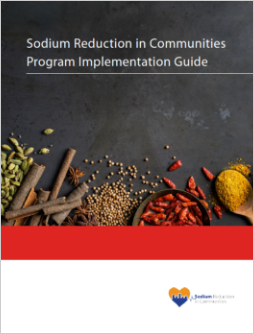Sodium Reduction in Communities Program (SRCP) Implementation Guide
What Is the Sodium Reduction in Communities Program Implementation Guide?
The purpose of this guide is to assist food service staff and public health organizations reduce sodium in food service organizations by drawing upon the experiences gained during the Sodium Reduction in Communities Program (SRCP).
The SRCP was launched by the Centers for Disease Control and Prevention (CDC) in 2010 to reduce the sodium intake of people in the United States by helping to create healthier food environments.
State and local health departments that received SRCP funding have worked with food service organizations to increase the availability and purchase of lower-sodium food options.
Over the last 11 years, state and local health departments and their partner institutions tested multiple approaches to sodium reduction, and they identified four key strategies as the most effective and feasible:
- Implementing food service guidelines and nutrition standards
- Changing procurement practices
- Making meal or menu modifications
- Implementing environmental strategies or behavioral economics approaches
This guide provides information on how to implement activities related to each of these strategies.
Why Is Sodium Reduction Important?
Average sodium intake in the United States vastly exceeds the recommended amount. The 2020–2025 Dietary Guidelines for Americans recommends that adults consume no more than 2,300 milligrams (mg) of sodium each day, yet adults consume on average 3,393 mg of sodium each day.1 This is more than 1,000 mg over the daily recommendation.2
In the United States, high sodium intake originates primarily from processed foods and foods prepared outside the home—sources that patrons have little control over.3
High sodium intake is associated with hypertension,4 a common and costly health risk in the United States.5 Even modest sodium reductions can lead to significant decreases in blood pressure and potentially lead to enormous savings both in lives and in dollars.6,7 Food service organizations are well-positioned to help their patrons reduce sodium intake and ultimately improve patrons’ health.
Who Should Use the Sodium Reduction in Communities Program Implementation Guide?
Food service staff, including registered dietitians, food service managers/directors, executive chefs, and food service line staff, can draw upon this guide to plan, implement, and maintain sodium reduction activities.
This guide will help public health staff determine how to support partners in planning, implementing, and maintaining sodium reduction strategies to achieve lasting change.

